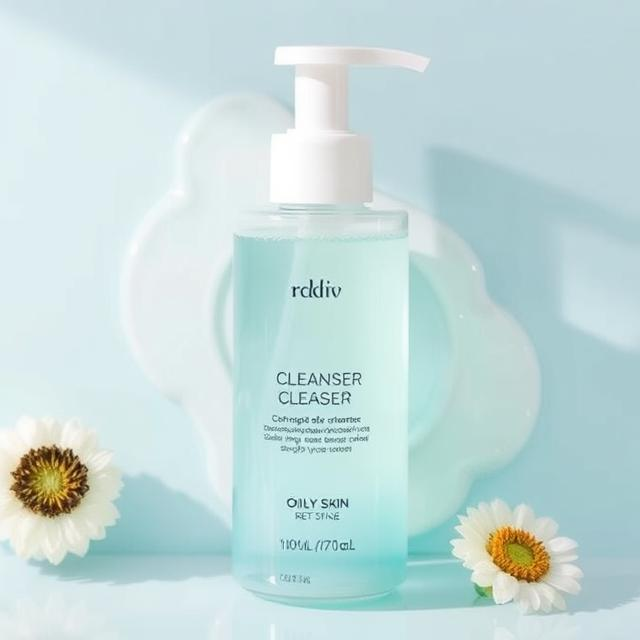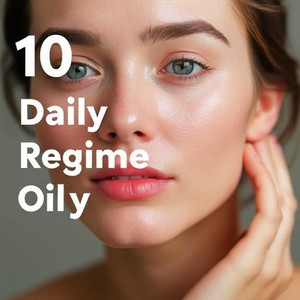Oily skin is a common skin type, characterized by excess sebum production that can make the skin appear shiny and more prone to acne and breakouts. The key to managing oily skin is to maintain a balanced skincare routine that helps control excess oil without stripping the skin of its natural moisture. While the excess sebum may seem like a burden, it also provides some protection to the skin and keeps it hydrated. A consistent skincare regimen focused on controlling oil production, reducing shine, and preventing clogged pores is essential. Here is a step-by-step guide to a daily skincare regimen that will work wonders for oily skin types.
1. Gentle Cleanser (Morning and Night)
The first step in any skincare routine is cleansing. For oily skin, it’s essential to use a gentle foaming or gel cleanser that effectively removes dirt, excess oil, and impurities without over-drying or irritating the skin. Look for products that are specifically formulated for oily skin, as they will help control oil production without causing your skin to feel stripped or tight.
Cleansing twice a day, once in the morning and once before bed, ensures that the pores stay clear and the skin doesn’t become too oily throughout the day. It also helps prevent acne breakouts by eliminating the buildup of dirt and oil.

2. Exfoliate (2-3 Times a Week)
Exfoliation is a crucial step for oily skin types, as it helps remove dead skin cells, preventing clogged pores and the formation of blackheads and whiteheads. However, over-exfoliating can lead to irritation and an increase in oil production, so it’s essential to exfoliate gently and not more than two to three times a week.
Look for chemical exfoliants containing salicylic acid or glycolic acid, as these ingredients help to deeply penetrate pores and dissolve excess oil and impurities. Avoid harsh physical exfoliants, as they can irritate the skin and make oil production worse.

3. Toner (Morning and Night)
Toners are great for oily skin because they help remove any remaining oil, dirt, and makeup after cleansing while balancing the skin’s pH levels. Look for toners containing ingredients like witch hazel, tea tree oil, or niacinamide, which help to control oil production and minimize pores.
Alcohol-free toners are preferable for oily skin types, as alcohol can dry out the skin, causing it to produce even more oil in compensation. Applying toner with a cotton pad in the morning and night after cleansing will help keep oil under control and prepare your skin for the next steps in your skincare routine.

4. Serum (Morning)
In the morning, incorporate a lightweight, oil-free serum into your skincare regimen. Serums containing niacinamide, salicylic acid, or hyaluronic acid can help regulate oil production, minimize pores, and hydrate the skin without adding extra shine. Niacinamide is particularly effective at controlling sebum production, reducing redness, and improving skin texture.
Choose a serum that is non-comedogenic, meaning it won’t clog your pores. Applying a serum in the morning before moisturizing helps to target specific skin concerns, such as acne or enlarged pores, while keeping your skin balanced.
5. Moisturizer (Morning and Night)
Even if you have oily skin, moisturizing is still a critical step in your daily skincare routine. Skipping moisturizer can lead to dehydration, which may cause the skin to produce even more oil in an attempt to compensate. Opt for an oil-free, lightweight gel-based moisturizer that hydrates without making your skin greasy.
Look for formulas containing glycerin or hyaluronic acid, which provide moisture without adding excess oil. A good moisturizer helps keep your skin’s barrier intact, reducing the risk of irritation and breakouts. Apply it both morning and night after your serum.
6. Sunscreen (Morning)
Sunscreen is a must for every skin type, but it’s particularly essential for oily skin types, as sun exposure can exacerbate acne and make oily skin appear shinier. Choose a broad-spectrum sunscreen with an SPF of 30 or higher that is formulated for oily skin.
Gel-based or oil-free sunscreens are ideal for oily skin types, as they provide sun protection without feeling heavy or greasy on the skin. Be sure to apply sunscreen every morning as the final step in your skincare regimen, even on cloudy days or when staying indoors, as UV rays can penetrate windows and cause skin damage.

7. Spot Treatment (As Needed)
For those occasional breakouts or acne flare-ups, a spot treatment can be added to your skincare routine. Look for products containing benzoyl peroxide or salicylic acid, as these ingredients work effectively to target pimples and prevent future breakouts.
Apply spot treatment directly to blemishes after moisturizing, but avoid using it all over your face, as it can be too harsh for your skin. Using a spot treatment as needed helps to manage acne without disrupting your entire skincare regimen. Be patient with spot treatments, as they can take time to show visible results.

8. Clay Mask (1-2 Times a Week)
Clay masks are an excellent option for oily skin, as they absorb excess oil, unclog pores, and purify the skin. Clay masks containing ingredients like kaolin or bentonite clay are particularly effective at controlling oil production and preventing breakouts.
However, it’s important not to overuse clay masks, as they can be drying if used too frequently. Once or twice a week is sufficient to maintain oil control and keep your skin feeling refreshed. Apply the mask to clean, dry skin and leave it on for the recommended time before rinsing it off with lukewarm water.

9. Retinol (Night)
Retinol, a form of vitamin A, is an excellent ingredient for oily skin, as it helps increase cell turnover, reducing clogged pores and minimizing the appearance of acne. It also has anti-aging benefits, helping to reduce fine lines and improve skin texture.
Incorporating a retinol product into your nighttime skincare routine can promote smoother, clearer skin. Start by using retinol 2-3 times a week and gradually increase the frequency as your skin gets used to it. Retinol can be irritating at first, so make sure to apply it after your moisturizer to minimize sensitivity.

10. Hydrating Mist (As Needed)
Throughout the day, your skin may need a quick refresh, especially if you’re prone to oiliness or feel like your skin is becoming too shiny. A hydrating mist is a great way to control oil while keeping your skin hydrated. Look for a mist that contains soothing ingredients like aloe vera, green tea, or chamomile, which help to balance oil production while calming the skin.
Hydrating mists are great for setting makeup or refreshing the skin during the day, without adding extra oil or causing breakouts. Just be sure to use a product designed for oily skin to avoid clogging your pores.
Having oily skin doesn’t mean you have to struggle with excess shine, breakouts, or clogged pores. By following a daily skincare regimen that includes the right products and ingredients, you can keep oil production under control, maintain a healthy complexion, and reduce the likelihood of acne flare-ups.
Remember, consistency is key – stick to your routine and give your skin time to adjust. By incorporating these 10 steps into your skincare regimen, you’ll be able to manage oily skin effectively, achieving a balanced, clear, and healthy-looking complexion.

